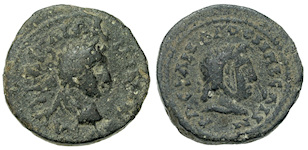Fine Coins Showcase
Antiquities Showcase
Show Empty Categories
Shop Search
Shopping Cart
My FORVM
Contact Us
About Forum
Shopping at Forum
Our Guarantee
Payment Options
Shipping Options & Fees
Privacy & Security
Forum Staff
Selling Your Coins
Identifying Your Coin
FAQs
zoom.asp
Home ▸ Catalog ▸ |Judean & Biblical Coins| ▸ |Holyland Rarities||View Options:   | | | | | | |



Jerash, Jordan is north of the national capital Amman. Inhabited since the Bronze Age, it's known for the ruins of the walled Greco-Roman city Gerasa just outside the modern city. Josephus mentions the city as being principally inhabited by Syrians, but also having a small Jewish community. In 106, Jerash was absorbed into the Roman province of Arabia, which included Philadelphia (modern day Amman). Jerash is considered one of the largest and most well-preserved sites of Roman architecture outside of Italy. It is sometimes referred to as the "Pompeii of the Middle East" due to its size, extent of excavation and level of preservation.RP57203. Bronze AE 20, RPC Online VI T9306.4 (same c/m, 7 spec.); Spijkerman 34a.3 (same coin); Rosenberger 41 (same c/m); Sofaer 32; c/m: Howgego 376 (9 spec.), Choice F, well centered, nice sea-green patina, rare fully legible rev. legend; c/m: F, weight 7.065 g, maximum diameter 19.7 mm, die axis 180o, Gerasa (Jerash, Jordon) mint, c. 218 - 222 A.D.; obverse AVT KAICAP ANTWNINOC, laureate and draped bust right, seen from behind; reverse AΛEΞANΔPOC MAKEΔWN, diademed head of Alexander the Great right, countermark: strung bow; very nice for the type!; very rare; $500.00 (Ä470.00)
Persian Empire, Samaria, c. 375 - 332 B.C.


Samaria was the capital of the northern Kingdom of Israel in the 9th - 8th centuries B.C. The Assyrians took the city and the northern kingdom in 722/721 B.C. The city did not recover until the Persian period, the mid 5th century. The tensions between the ruling Sanballat family and Jerusalem under the governorship of Nehemiah are documented in the Bible (Ezra 4:10, Neh 4:7Ė8). Samaria became Hellenistic in 332 B.C. Thousands of Macedonian soldiers were settled there following a revolt. The Judaean king John Hyrcanus destroyed Samaria in 108 B.C., but it was resettled under Alexander Jannaeus. In 63 B.C., Samaria was annexed to the Roman province of Syria. Herod the Great fortified the city and renamed it Sebaste. The ruins are located in the Samaria mountains almost 10 km to the northwest of Nablus.GS110668. Silver ma'ah-obol, Meshorer-Qedar 188, Sofaer 165, HGC 10 -, Sunrise -, Hendin -, SNG ANS -, VF, centered, toned, light marks, die break upper reverse, weight 0.614 g, maximum diameter 9.7 mm, die axis 180o, Samaria (Sebastia, West Bank) mint, c. 375 - 332 B.C.; obverse head of the satrap right, bearded, wearing Kyrbasia (Persian tiara); reverse head right, bare-headed, bearded; ex Gorny & Mosch auction 289 (10 Oct 2022), lot 422; ex Gert Cleff Collection (Wuppertal); ex Italo Vecchi (London) auction 10 (24-25 Mar 1998), lot 436; rare; $400.00 (Ä376.00)
Hadrian, 11 August 117 - 10 July 138 A.D., Ascalon, Philistia, Judaea, Extremely Rare Duel Dated Variant


RPC Online III notes of their specimen, "The date does seem to begin with E, even though one would expect ς with year 4 of the second era. Confirmation required. If correctly read, it might show that the Hadrianic era began at a different time of year from the normal city era, or it might just be a mistake, as commonly happened at Gaza." Our coin appears to have the expected date, but with a reversed ς.RP111379. Bronze AE 24, Unpublished variant, RPC Online III 4014A var. (EKC, the only known specimen), VF, attractive highlighting earthen deposits, rev. off center, weight 12.265 g, maximum diameter 23.5 mm, die axis 0o, Askalon (Ashqelon, Israel) mint, 132 - 133 A.D.; obverse CEBAC-TOC (starting counterclockwise on right, ending counterclockwise on left), laureate, draped and cuirassed bust right, seen from behind; reverse ACKΛAW upward on left, Tyche-Astarte standing half left on prow, head left, vexillum standard in right hand, aphlaston in left hand, LΔ (year 4 [of Hadrian]) over incense altar inner left; dove standing left over ΣKC ([year] 226 [of Ascalon], Σ reversed) lower right; extremely rare; $400.00 (Ä376.00)
CLICK HERE TO SEE MORE FROM THIS CATEGORY - FORVM's PRIOR SALES



Page created in 1.391 seconds.








